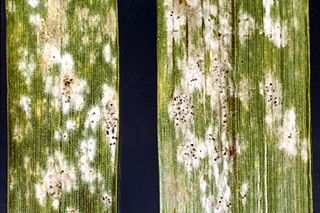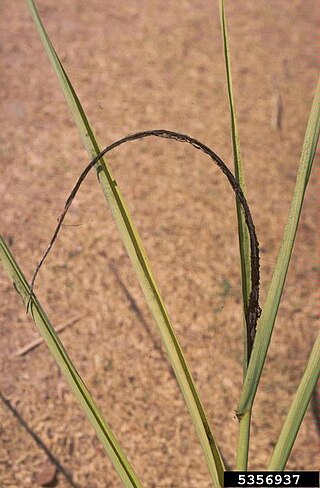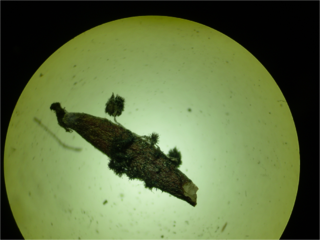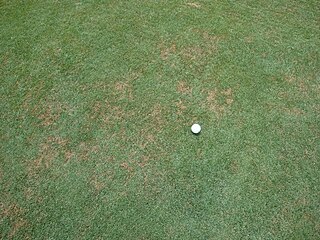
Alopecurus pratensis, known as the meadow foxtail or the field meadow foxtail, is a perennial grass belonging to the grass family (Poaceae). It is native to Europe and Asia.

The smuts are multicellular fungi characterized by their large numbers of teliospores. The smuts get their name from a Germanic word for 'dirt' because of their dark, thick-walled, and dust-like teliospores. They are mostly Ustilaginomycetes and comprise seven of the 15 orders of the subphylum. Most described smuts belong to two orders, Ustilaginales and Tilletiales. The smuts are normally grouped with the other basidiomycetes because of their commonalities concerning sexual reproduction.

Blumeria graminis is a fungus that causes powdery mildew on grasses, including cereals. It is the only species in the genus Blumeria. It has also been called Erysiphe graminis and Oidium monilioides or Oidium tritici.

Sugarcane smut is a fungal disease of sugarcane caused by the fungus Sporisorium scitamineum. The disease is known as culmicolous, which describes the outgrowth of fungus of the stalk on the cane. It attacks several sugarcane species and has been reported to occur on a few other grass species as well, but not to a critical amount. The most recognizable characteristic of this disease is a black or gray growth that is referred to as a "smut whip". Resistance to sugarcane smut is the best course of action for management, but also the use of disease free seed is important. On smaller scale operations treatments using hot water and removing infected plants can be effective. The main mode of spore dispersal is the wind but the disease also spreads through the use of infected cuttings. Sugarcane smut is a devastating disease in sugarcane growing areas globally.

Take-all is a plant disease affecting the roots of grass and cereal plants in temperate climates caused by the fungus Gaeumannomyces tritici. All varieties of wheat and barley are susceptible. It is an important disease in winter wheat in Western Europe particularly, and is favoured by conditions of intensive production and monoculture.

The fungal genus Pyrenophora includes 108 species, including the following plant pathogenic species: Pyrenophora teres, Pyrenophora graminea and Pyrenophora tritici-repentis.

Loose smut of barley is caused by Ustilago nuda. It is a disease that can destroy a large proportion of a barley crop. Loose smut replaces grain heads with smut, or masses of spores which infect the open flowers of healthy plants and grow into the seed, without showing any symptoms. Seeds appear healthy and only when they reach maturity the following season is it clear that they were infected. Systemic fungicides are the major control method for loose smut.

Alternaria brassicae is a plant pathogen able to infect most Brassica species including important crops such as broccoli, cabbage and oil seed rape. It causes damping off if infection occurs in younger plants and less severe leaf spot symptoms on infections of older plants.

Pyrenophora tritici-repentis (teleomorph) and Drechslera tritici-repentis (anamorph) is a necrotrophic plant pathogen of fungal origin, phylum Ascomycota. The pathogen causes a disease originally named yellow spot but now commonly called tan spot, yellow leaf spot, yellow leaf blotch or helminthosporiosis. At least eight races of the pathogen are known to occur based on their virulence on a wheat differential set.

Zymoseptoria tritici, synonyms Septoria tritici, Mycosphaerella graminicola, is a species of filamentous fungus, an ascomycete in the family Mycosphaerellaceae. It is a wheat plant pathogen causing septoria leaf blotch that is difficult to control due to resistance to multiple fungicides. The pathogen today causes one of the most important diseases of wheat.

Tilletia caries is a basidiomycete that causes common bunt of wheat. The common names of this disease are stinking bunt of wheat and stinking smut of wheat. This pathogen infects wheat, rye, and various other grasses. T. caries is economically and agriculturally important because it reduces both the wheat yield and grain quality.

Urocystis agropyri is a fungal plant pathogen that causes flag smut on wheat.
Urocystis brassicae is a gall smut and a plant pathogen that stunts the infected plants. It is known to create root galls on Indian Mustard and other Brassica species.
Urocystis occulta is a smut fungus which attacks the leaves and stalks of rye.

Puccinia recondita is a fungus species and plant pathogen belonging to the order of Pucciniales and family Pucciniaceae.
Fusarium crookwellense is a species of fungus in the family Nectriaceae. It is known as a plant pathogen that infects agricultural crops.
Urocystis tritici is a fungal plant pathogen in the family Urocystidiaceae.

Alopecurus geniculatus is a species of grass known by the common name water foxtail or marsh foxtail. It is native to much of Eurasia and introduced into North America, South America, and Australia. It grows in moist areas.

Turf melting out is caused by the fungal pathogen Dreschlera poae, in the family Pleosporaceae. It is a common problem on turfgrass and affects many different species. The disease infects all parts of the plant most commonly on golf course roughs, sports fields, and home lawns. There are two stages of the disease: the leaf blade infection and the crown and root infection Melting out occurs during the cool weather of April and May and is encouraged by high nitrogen fertility. The disease is spread by wind-blown or water splashed spores and survive in thatch.
Urocystis alopecuri is a fungal plant pathogen in the family Urocystidiaceae. Known as 'Foxtail Smut'.















